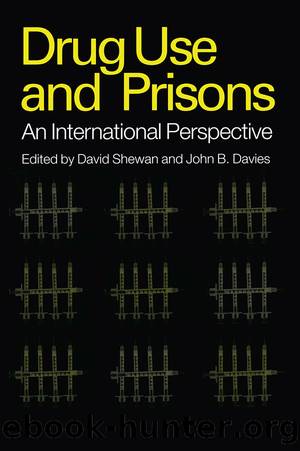Drug Use in Prisons by Shewan

Author:Shewan [Shewan]
Language: eng
Format: epub
Tags: Social Science, Criminology, Sociology, General
ISBN: 9781134432349
Google: QZ5lAgAAQBAJ
Publisher: Routledge
Published: 2013-12-19T04:56:36+00:00
However, there are some reports from Uganda (Orley and Wing, 1979) and Zambia (Rwegellera, 1981) which indicate patterns of depressive symptomatology similar to Caucasian cultures. Also from Uganda, Assael and German (1970) reported on a comparative study of psychiatric morbidity among University students from Makerere in Uganda, Belfast and Edinburgh in the UK. They found the following prevalence rates for personality disorders: 7.4 per cent for Uganda, 7.0 per cent for Belfast, and 5.2 per cent for Edinburgh. It would be interesting to see how this general population situation is reflected in prisons.
This review is limited by the virtual lack of published works on psychiatric morbidity in prison populations, outside of Nigeria. Even in South Africa with a generous presence of psychiatric researchers, the available papers in this regard are mostly concerned with mental disorders among former political detainees who suffered from denial of human rights during the apartheid era.
On the other hand, there is an impressive number of works from Nigeria. However, most of these studies are based on psychiatric evaluation of either criminals referred to hospitals for treatment (Makanjuola and Olaomo, 1981; Baiyewu, 1988; Abiodun, 1986; Ihezue et al., 1993; Akinnawo, 1993; Udofia, 1997), homicide cases in prisons (Asuni, 1969; Agomoh, 1993), or retrospective reviews of forensic cases in long-stay units of hospitals (Odejide, 1981; Ogunlesi, 1988). Less commonly, there have been systematic assessments of prison populations for personality disorders (Enyidah, 1993), general psychiatric morbidity (Agbahowe et al., 1998) and drug abuse (Adesanya et al., 1997), using modern standard instruments. In the studies that focused on hospitalised mentally ill offenders, schizophrenia (mostly of the paranoid type) was the commonest diagnosis (43 per cent to 75 per cent); and other diagnostic categories were epilepsy (6 per cent to 18.5 per cent), personality disorders (15 per cent) and drug abuse (19.5 per cent). Of the studies that assessed homicide cases in prisons, schizophrenia (27 per cent to 50 per cent) was again the commonest diagnosis. When personality disorders were systematically assessed in a maximum security prison, it was found that 52 per cent (of 213 males) fulfilled ICD-10 criteria for personality disorders. However assessment for personality disorders among patients compulsorily admitted in hospital by the courts suggested that there were no âpsychopathsâ in one study (Baiyewu, 1988); while a second study diagnosed only 1.1 per cent (out of 354) as having psychopathy, which was significantly higher than the figure for a control group of psychiatric patients (0.3 per cent) (Udofia, 1997). In the most recent study of 100 inmates of a medium security hospital, six subjects were diagnosed as having antisocial personality disorder, using DSM-III-R criteria (Agbahowe et al., 1998).
Reports from Kenya and Tanzania support the Nigerian findings. In a study of a group of criminal patients at Kenyaâs main mental hospital, Mathari Mental Hospital, no single case of âpsychopathic disorderâ was found (Muluka and Acuda, 1978).
However, Mbatia and Ferguson (1995â1996), in a comparative study of mentally ill offenders at Isanga Institution (a special hospital in Tanzania for criminals) with
Download
This site does not store any files on its server. We only index and link to content provided by other sites. Please contact the content providers to delete copyright contents if any and email us, we'll remove relevant links or contents immediately.
Application of a Novel Technique for Clinical Evaluation of Nitric Oxide-Induced Free Radical Reactions in ICU Patients by Unknown(696)
Rosenâs Emergency Medicine Concepts and Clinical Practice by Ron Walls; Robert Hockberger; Marianne Gausche-Hill; Timothy B. Erickson; Susan R. Wilcox(572)
Oxidative damage to surfactant protein D in pulmonary diseases by Vitality Starosta1 & Matthias Griese1†(408)
Social Science Perspectives on Global Public Health by Vincent La Placa & Julia Morgan(375)
Constructing Canine Consent; Conceptualising and Adopting a Consent-focused Relationship with Dogs by ERIN JONES(330)
Organic Chemistry: An Acid - Base Approach by MICHAEL SMITH(300)
ADVANCED EMERGENCY CARE AND TRANSPORTATION OF THE SICK AND INJURED by Unknown(271)
Saunders Nursing Drug Handbook 2024 - E-Book by Unknown(263)
Davis's Comprehensive Manual of Laboratory and Diagnostic Tests with Nursing Implications by Unknown(249)
Socio-Life Science and the COVID-19 Outbreak : Public Health and Public Policy by Makoto Yano; Fumihiko Matsuda; Anavaj Sakuntabhai; Shigeru Hirota(247)
Diagnostic and Statistical Manual of Mental Disorders, Fifth Edition, Text Revision (DSM-5-TR(tm)) by Unknown(246)
Human Microanatomy; Cell Tissue and Organ Histology with Celebrity Medical Histories by Stephen A. Stricker(245)
Berne and Levy Physiology E-Book by Unknown(236)
Replacing the Dead by Mie Nakachi;(231)
Handbook of Skin Disease Management by Jiyad Zainab;Flohr Carsten; & Carsten Flohr(229)
Access to Medicines and Vaccines in the South : Coherence of Rules and Policies Applied by the European Union Commission by Stephen Kingah(226)
Deep Learning and Medical Applications by Unknown(222)
The Pocket Guide to Sensorimotor Psychotherapy in Context (Norton Series on Interpersonal Neurobiology) by Pat Ogden(218)
Advances and Technical Standards in Neurosurgery by Unknown(215)
